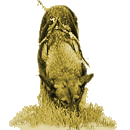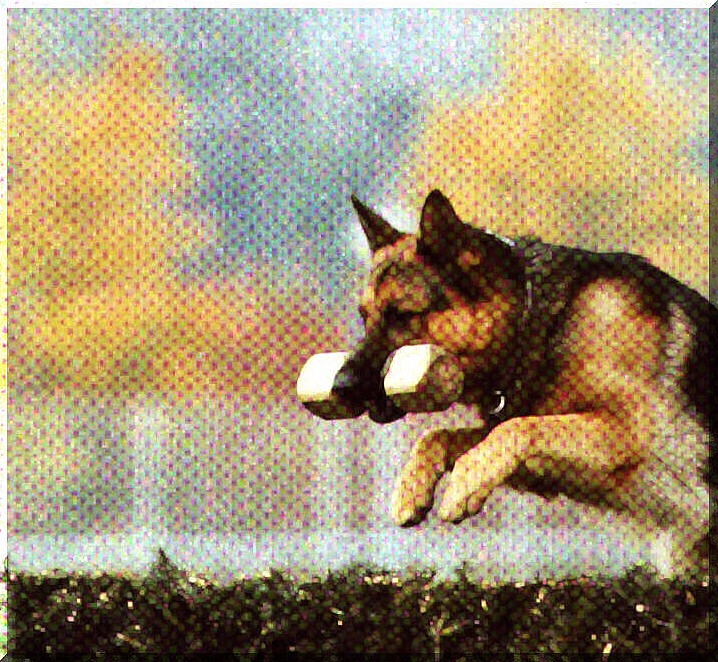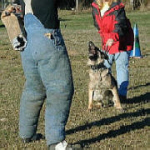What is
Schutzhund?
The purpose of Schutzhund training is to assess and mold the dog's natural
abilities to track, protect, and teach the dog control through obedience. It
has been considered by some to be a test for breeding in that during the
training the degree to which the dog possesses these working abilities
becomes apparent. There are three degrees of Schutzhund training: SchH1 or
novice; SchH2 or intermediate; and SchH3 or advanced.
To be eligible to do Schutzhund training, it is essential that the dog have
a sound temperament. It cannot be shy, sharp shy, vicious, or have poor
nerves (that is easily rattled). A responsible trainer will never train a
dog with poor temperament in Schutzhund. It is also important that the
trainer know when to back down and when to admit ignorance in order to keep
from ruining a dog.
Good socialization during puppyhood is critical. Poorly socialized dogs will
have problems getting started and will require more ground work.
The tracking is very similar to the AKC TD and TDX, except the dog is
penalized for quartering (that is sniffing from side to side down the
track). This phase of training can be started when the dog is about five
months old.
The obedience portion is very similar to that of the AKC CDX work except it
is done on a large field as opposed to a small ring. This is for SchH1. For
SchH2 and 3 obedience, the dog has to scale a 6 foot tall slanted wall to
retrieve a dumbell in addition to the SchH1 exercises. The dog is expected
to do the work with greater precision at the more advanced levels. This
portion of the training is usually started in earnest at about 12 months of
age. Basic puppy training is always a good idea.
The protection phase consists of developing the dog's natural protective
instincts, and teaches it control in full drive through obedience exercises.
The protection phase is best started no earlier than 15 months of age. The
dog needs to have developed emotionally as well as physically and mentally.
Schutzhund training is very time consuming and requires a commitment from
the owner. The length of time it takes to attain a SchH1 title will depend
upon the dog's abilities and the time commitment made by the owner. This can
range from three months under ideal conditions (two times tracking/wk; four
times/wk of obedience; four times/wk of protection) to three years if the
training is sporadic or of poor quality.
There is a difference between Schutzhund Training and a Schutzhund Trial.
When done properly the training is a good test of the dog. A strong dog
doesn't always do well at trials because they can be a bit obstinate during
the obedience phase. A dog that scores well may not be a good dog.
Schutzhund Organizations
In Germany,
the two largest Schutzhund organizations are the SV (GSD Dog Club) and the
DVG (German Alliance for Utility Dog Sports). In 1975, the first Schutzhund
organization in the US, United Schutzhund Club of America (USA), was formed.
Soon after, an American branch of the DVG formed. The USA's address and
phone numbers are in the Resources section. (Breeding requirements for the
United Schutzhund Clubs of America include a minimum of an "a" stamp and BH
(German Companion Dog).
Schutzhund Trials
Trials involve 3
different phases,

These 3 are
all designed to test the natural drives, temperament and abilities of the
dog. Courage, endurance and willingness to work are a few of the traits
necessary for a dog to excel in Schutzhund.
The German Shepherd is a working dog and should always be bred with
that goal in mind. Dogs that possess the traits that are necessary in
Schutzhund also make excellent companions and family pets.
Schutzhund is a great sport for both dog and handler. It will
strengthen the bond between the two as well as be a forum to make new
friends along the way. Schutzhund people seem to be a breed all their own,
most with such a strong conviction and love of the breed, you know they
can't be anything but "good people!"
Schutzhund is a sport for all who are willing to put forth the effort it requires. People of all ages and walks of life enjoy schutzhund- even those with significant disabilities. Often, it's a family sport. Any breed or mixed breed of dog can compete. However, size is a factor - the jump is fixed at 39 inches. The A-frame is fixed at 5 feet (Sch II) and 6 feet (Sch III). The dog must also be able to handle the protection work. The dog need not be intact. Typical breeds competing are German Shepherd Dogs, Rottweilers, Boxers, Doberman Pinschers, Bouviers, and Belgian Malinois.
The German Sieger Show and Other SV and SV-Style Shows
Fred Lanting
There are a number of differences between the way the GSDCA National Specialty is run and the methods employed in conducting the (World) Sieger Show in Germany and the SV-sanctioned Sieger Shows in other countries. Besides being international in scope, the Sieger Show is completely controlled by the SV, not some supra-organization such as the AKC. They therefore can set requirements that would not be allowed here in the US. The main judges are the same year after year, until new officers are elected. No one is allowed to judge any SV show, much less classes at the Sieger Show, until he has passed extensive training, an apprenticeship, and won the approval of officials in the organization. This main breed show is held in a different city in Germany each year.
AKC Ring Procedure Differences
The spectator or exhibitor who is used to only one type of dog show may want to know what is going on, and why, at another event. The best way is to find someone showing more than one dog and simply ask if he has a few minutes to explain the procedures to you. At an AKC or CKC all-breed show, there are generally a considerable number of constraints, mainly "Newtonian" (i.e., time and space). Judges are expected to process at least 25 dogs per hour, and when you include the shuffling of papers, checking armband numbers, waiting for dogs to enter and exit the rings, and the difficulty some exhibitors have in "setting up" their dogs, there is pitifully little time spent going over each entry. Of course, a good judge can spot a good dog right away, and both I and a German friend are fond of saying (only partially tongue-in-cheek) that we can see a dog jump out of a car trunk, jump right back in, and can tell you the quality level in that instant. But a very short time is not fair to the exhibitor or to the breed.
In such an AKC ring at an multi-breed show, there is another judge and another breed or group waiting for your space. And that is the other major constraint: the dogs have a very small ring at most of these shows, so even in a small class they can only take a few steps before they have to make a right-angle turn. It is not fair to exhibitors or good for the breed to judge them as little more than statues. Judges in such venues customarily run the class around once, then individually check teeth, testicles, and hopefully other aspects, then move the dog down and back, and around to the end. Some vary the method from here on, with the better ones either temporarily placing the dogs in a large class at the time they do the individual exams, others taking notes so they can call out the dogs in order of preference after the "individuals". Those who do neither risk forgetting which dogs had the bad mouths, insecure temperaments, and other problems, and such dogs are often given the top awards because of this or lack of concern about the breed. Many judges at these shows have been "given" the breed simply because they are licensed to judge others in the group, and have filled out the application forms and passed the quiz on the Standard. Most have never seen anything but the extreme American fad dogs and think that style is correct.
--von Stephanitz
At the Sieger Show, all entrants in the Open Class (the Gebrauchshundklasse) are pre-screened by the judge the day before the extended gaiting, and then on the final day are admitted into the ring in order based on notes compiled in the preliminary standing exam. By that day, the judge has already put the entry numbers worn by the exhibitors into one or another column in his note pad, placing them in initial order of quality in either the V+, V, V-, SG+, SG, SG-, or other column, with the better of each group nearer the top and the poorer nearer the bottom of the columns. He will make minor changes in that line-up during the extended gaiting portion of his evaluation (at smaller shows, all this can be done on the same day). The entry is usually well over 100 in the Open Class, perhaps some 30 percent greater than a typical GSDCA National "Specials" class. These dogs also must have been surveyed, performed the courage test, be gun-sure, have a Schutzhund title, and have earned at least an SG (sehr gut) ranking at some previous competition such as one of the Landesgruppen "regional" shows. So, by the time the adult males enter the ring to be judged by the president of the SV (females are customarily judged by the chief Koermeister), their pedigrees and records are known to the judge.
Conversely, in AKC type shows the judge is not supposed to base his decision on anything other than what he sees in the ring on that day. This directive puts a terrible burden of dilemma on a judge who knows a certain dog is dysplastic, or of poor temperament, or produces very poorly, yet is under control and shows none of his problems on the day of the show. The previous-day initial look includes checking teeth, tattoos, and testicles, though sometimes with a big entry, a fellow judge will do this to save time.
Courage Test
--John 7:24
On the day prior to being judged in the "show" ring, the adults must also pass the courage tests in a different field or arena, while the younger dogs are being judged by someone else in the conformation ring. Elements of Schutzhund training are used to test the Working Class dog's character and willingness to protect his handler. While the two walk down the field, an agitator jumps out from behind a blind making threatening gestures. The dog must attack, bite full and hard, and hold on until commanded by his handler to release. The villain used to go through the escape-turn-threaten routine a second time, from far away, and the dog had to pursue and again attack this stick-wielding agitator. (Note: SV rules as of 1997 were changed to eliminate running away from the dog, and now the second "bad guy" comes out of a blind at the other end of the field and runs menacingly at the dog.) The dog must work well in spite of the cheers and other noises made by the enthusiastic crowd, something he is possibly not used to in his first tests or at a trial with a small turnout.
which is: the shepherd dog is a working dog!"
--von Stephanitz


